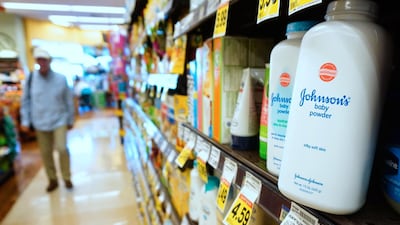Talcum powder has long been used by families around the world as an essential part of their skincare and baby-care rituals.
But as Johnson & Johnson faces thousands of lawsuits from consumers across the US who claim its talc products caused their cancer, is it time to turn to a more natural alternative?
While the healthcare giant has consistently defended the safety of its talc products, it this week announced it will no longer sell its Johnson's Baby Powder in the US and Canada.
The company currently faces more than 16,000 lawsuits that allege the products were contaminated with asbestos, a known carcinogen.
Announcing the withdrawal of the product, Johnson & Johnson said demand for Johnson's Baby Powder had been declining in North America "due in large part to changes in consumer habits and fuelled by misinformation around the safety of the product".
"We remain steadfastly confident in the safety of talc-based Johnson's Baby Powder. Decades of independent scientific studies by medical experts around the world support the safety of our product," it said.
The product remains on sale in the UAE and many other countries around the world.
Talcum powder is made from talc, a mineral made up mainly of the elements magnesium, silicon and oxygen. As a powder, it absorbs moisture well and helps cut down on friction, making it useful for keeping skin dry and helping to prevent rashes.
But it is not the only product that has such effects. Here are some natural alternatives to talcum powder, which you might already have in your kitchen cupboards …
1. Cornstarch
This everyday item, easily sourced from the baking aisle of your local supermarket, will offer very similar results to standard talcum powder. Derived from the endosperm of a corn kernel, this natural substance, usually used for baking and thickening, has a similar consistency to talc and will absorb liquid just as well.
2. Baking soda
Another bakery aisle saviour. While baking soda is already well known for its many uses away from baking, such as helping to remove stains and eliminating odours, it can also work as an alternative for talcum powder. It has good absorbing properties and will also help to gently exfoliate the skin, leaving it feeling soft and smooth.
3. Rice starch
Made from ground-up rice, the powdered substance was used long before talc as a way to absorb moisture and mattify skin. The downside to rice starch is that it has a tendency to cake on the skin, and it is harder to get hold of than some of the more readily available substitutes.
4. Oat flour
Oat flour is relatively cheap and can be found among the flours in most standard supermarkets, or better yet, can be easily made yourself at home by grinding up regular oats. Once ground, the powdered texture can prevent friction on the skin and act as a drying agent, however, its texture is more coarse than talc, so it will not sit on the skin quite as well.
5. Kaolin clay
Cosmetic clay, also known as kaolin clay, is found in many natural deodorants, soaps and other cosmetics. It works as a natural absorbent and is known to be extremely gentle on the skin. The downside is it is a little pricier than your average drying powder and harder to find, although, it can easily be bought online or in some specialist health stores.



